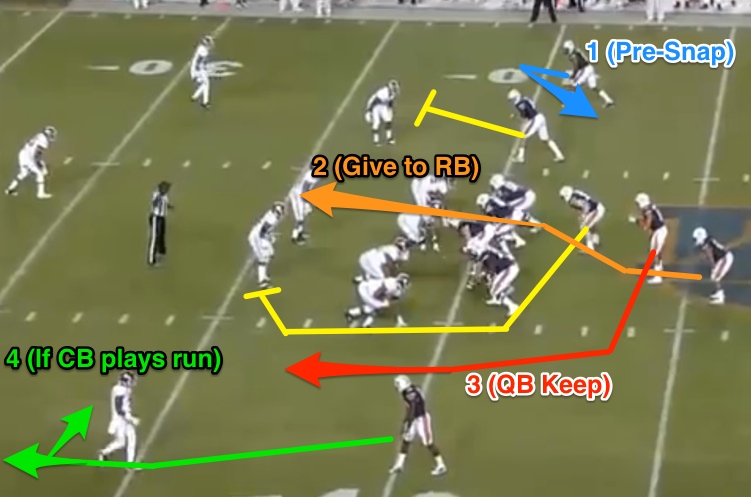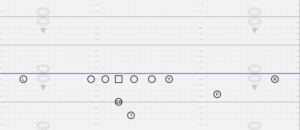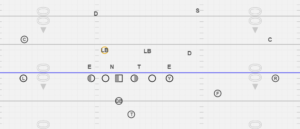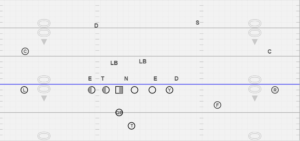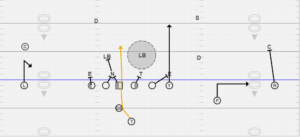How many times has this happened to you?
You call a run play in the game and you know it’s going to work because you’ve watched a year’s worth of film on your opponent. You come out in a certain formation expecting the defense to give you that look you’ve been craving because you know the perfect play to gash them with.
But, what’s this? The defense didn’t do what you thought they were going to do. Now you start to sweat. Do you run the play? Call something different? Call timeout?
Screw it.
You’ve called the play. The kids have to deal with it. You did an okay enough job teaching them throughout the week. Who cares if it is against a front you only talked during Thursday’s walkthrough. The kids are smart enough. They will adjust.
The quarterback calls the cadence. The center snaps the ball. The quarterback hands the ball off and the running back gets stuffed two yards in the backfield.
Does that scenario sound familiar to you?
Because it does to me. That’s happened way too much to my liking. So I’ve decided to do something about it. What have I done? I’ve gone to using one running scheme.
What running scheme? The Inside Zone.
Why You Should Only Run the Inside Zone Scheme
The reason is simple. Your kids will rep the piss out of it every day and get great at it. They will practice against every front, every blitz, every stunt, and everything a creative defensive coordinator can throw at you.
I know my kids did.
We repped the inside zone against the Under Front, Over Front, Bear Front, Over G Front, Double Eagle Front, Odd Front, Stack Front, Okie Front, American Fire Zone Front, Wag the Dog Front, Double Mike A Gap Super Blitz Front, and Super Double Power Eagle G Over Burning It All Down Front.
You name the blitz and/or stunt and our guys knew how to block it.
Why?
Because we did it every freaking day in practice. Individuals - Inside Zone drills. Team Run - Inside Zone blocking. Inside Drill - Inside Zone blocking. Team Tempo - Inside Zone blocking. Team - Inside Zone blocking.
Reps. Reps. Reps. Reps. Reps. That’s all my guys did in practice. Shoot, my guys blocked inside zone so much that they were taking their steps and shooting their hands while they were getting ready to go to bed.
And isn’t that the major secret about being successful on offense? Getting enough reps so your players can feel like they have mastered it?
Why You Won’t Stick to Inside Zone Scheme as the Only Scheme
Because you think you’re smarter than you really are.
That’s right, I said it. And you know it’s true. How do I know you know it’s true?
I’m the same as you. I always had to have four, five, or six running schemes because I thought I was smarter than I was. Hell, I knew the blocking schemes and adjustments against everything the defense did. So why shouldn’t my players, right?
Wrong.
You eat, sleep, and breath football. Your players eat, sleep, breath other things - video games, food, getting laid. You know, things that really matter.
Don’t believe me? Turn on your film and count how many times you blame the kids for missing a block.
News flash buddy. It isn’t the kid’s fault. It’s yours.
How do you Block Your Inside Zone?
There are two schools of thought on blocking the Inside Zone - Vertical displacement or Horizontal displacement.
Vertical Displacement is were you focus on double-teaming the down linemen into the laps of the linebackers.
Horizontal displacement is where your guys are blocking the down linemen left or right and letting your runningback make the play.
Which one do we use?
Horizontal displacement. Why? Because it is super easy to teach. All my guys have to do is step to the direction the play is going and protect their gap for three steps. If someone shows up in that gap within three steps then that’s who they block. If someone doesn’t show up in their gap in three steps then they climb to the next level.
It’s that simple.
Blocking Inside Zone Against an Over Front
PST - He has a defender over him. He takes three steps to the right while asking himself, “Is there a defender in my play side gap?” Most of the time that five technique will stay with him because he is taught not to get reached. So on the third step, the tackle will stay on the block.
PSG - He does not have a defender over him, yet he is still taking his three steps toward his play side gap. He is asking himself, “Is there anyone showing up in my gap?” If the five technique doesn’t spike inside or a linebacker shoot into the gap then he will work to the second level.
Center - He has a shade on him. Doesn’t matter. He will still take three steps toward his play side gap. He is asking himself, “Is this shade attacking my gap?” If the answer is yes then he will be pushing the defender to the right. If the shade spikes across his face by the third step then he will work up to the second level.
BSG - He has a three-technique on his backside. Doesn’t matter because he is asking himself, “Is there someone in my play side gap?” He is taking three steps to make sure no one shows up. If someone shows up within those three steps then he will block him. If no one shows up in three steps then he will work to the second level.
BST - He has a defender in his play side gap. Doesn’t matter however because he is asking himself “Do I have anyone in my play side gap?” He will take three steps to the right while checking his gap. If that three-technique stays in the B gap then the tackle will wash him out. If that defender does something strange and goes away from the B gap then the tackle will work up to the second level on his fourth step.
Blocking Inside Zone Scheme Against an Under Front
PST - He has a defender over him. He takes three steps to the right while asking himself, “Is there a defender in my play side gap?” Most of the time that five technique will stay with him because he is taught not to get reached. So on the third step, the tackle will stay on the block.
PSG - He has a three-technique in his play side gap. Doesn’t matter because he is asking himself, “Is there someone in my play side gap?” He is taking three steps. If that three-technique stays in his gap then he will block him. If that three-technique spikes into the A gap then he will move to the second level.
Center - He doesn’t have a defender in his gap. Doesn’t matter though. He will still take three steps toward his play side gap. He is asking himself, “Is anyone showing up in my gap?” If the answer is yes then he will lock onto that defender. If the answer is no by his third step then he will climb to the second level.
BSG - He has a shade on him. Doesn’t matter though. He will still take three steps toward his play side gap. He is asking himself, “Is this shade attacking my gap?” If the answer is yes then he will be pushing the defender to the right. If the shade spikes across his face by the third step then he will work up to the second level.
BST - He has a defender on his outside. Doesn’t matter however because he is asking himself “Do I have anyone in my play side gap?” He will take three steps to the right while checking his gap. If no one shows up then the tackle will work up to the second level on his fourth step.
Blocking Inside Zone Scheme Against an Odd Front
PST - He has a defender over him. He takes three steps to the right while asking himself, “Is there a defender in my play side gap?” Most of the time that five technique will stay with him because he is taught not to get reached. So on the third step, the tackle will stay on the block.
PSG - He does not have a man over him, yet he is still taking his three steps toward his play side gap. He is asking himself, “Is there anyone showing up in my gap?” If the five technique doesn’t spike inside or a linebacker shoot into the gap then he will work to the second level.
Center - He has a defender on him. Doesn’t matter though. He will still take three steps toward his play side gap. He is asking himself, “Is this nose guard attacking my gap?” If the answer is yes then he will be pushing the defender to the right. If the nose guard spikes across his face by the third step then he will work up to the second level.
BSG - He does not have a defender over him, yet he is still taking his three steps toward his play side gap. He is asking himself, “Is there anyone showing up in my gap?” If the nose guard doesn’t spike inside or a linebacker shoot into the gap then he will work to the second level.
BST - He has a defender over him. He takes three steps to the right while asking himself, “Is there a defender in my play side gap?” Most of the time that five technique will stay outside of him because is the quarterback player. However, if the five-technique tries to cross the tackles face then he will wash him out of the play.
Spicing Up the Inside Zone Scheme with Tags
I know what you are thinking. Coach, this is all well and good, but defenses will be able to stop our run game because we are only RUNNING ONE FREAKING SCHEME.
In the immortal words of Lee Corso, “NOT SO FAST SWEETHEART!”
We are going to use something special. Something sexy. Something that makes the inside zone look different to the defense yet makes it super simple to the offense.
What am I talking about?
Tags. Hot, sweating, sexy tags.
What are tags? These are little keywords that tell one player to change his assignment without messing with the rest of the players.
LOCK TAG
The first tag we add to the inside zone scheme is our lock scheme. This only affects the backside guard and tackle.
How?
By having them lock onto their defenders. It’s simple: the tackle is always locked on to the man head up to outside of him. The backside guard is only locked on if he has a man head up to outside of him.
Example 1: The guard has a guy head up to outside of him. Therefore he locks on.
Example 2: Does the guard have a man head up to outside of him? Nope. So he does his normal inside zone steps.
Example 3: Same thing in the odd front. Nobody head up or outside of the backside guard, so he does his normal steps.
This tag is amazing because now you have turned the Inside Zone Scheme into an RPO. You will have the slot wide receiver run a three-step hitch. The quarterback is reading the backside linebacker. If the linebacker fills, then he will pull the ball and drill the hitch. If the linebacker drops then the quarterback will hand the ball off.
Simple as that.
CAP TAG
This tag utilizes an H-Back. Yes, I believe you need an H-Back to be able to run this scheme right and be efficient.
(Yeah, I said it. Are you happy now? Jerks.)
What the CAP tag does is tell the H-Back to cross the formation and kick out the defender that is in the C-gap.
You can get creative with this tag. You can tag it with your quick game, dropback game, or screen game. This tag also allows you to change the person you want to read on your RPO. You can read a linebacker, a safety, or a corner. The possibilities are endless.
RPO off of a Linebacker
RPO off of a Safety
RPO off of a Corner
SLICE TAG
The last tag is a counter to the CAP tag. When you use this tag you are telling the H-back to fake the CAP block and go straight to the flats.
The quarterback will now read the C-gap defender for his give or pull read. If the C-gap defender runs up the field, then the quarterback will hand the ball off. If the C-gap defender crashes down the line of scrimmage, then the quarterback will pull the ball and throw it to the H-back.
Notice how nothing changes for the offensive line. The only players doing something different is the H-back and the wide receivers. This play is devastating to the defense. They tend to forget about the H-back being a passing threat. I love to call this play when I’m in the Red Zone.
There You Go
That’s how I use Inside Zone as my only running scheme. I believe it’s the most versatile scheme in all of football because of all of the tags you can incorporate into it. This scheme lets you call plays fast, let’s your kids be confident in knowing how to block every front, and lets you score a crap ton of points fast.
Please let me know if you do anything different. I’d love to hear from you’ll.
Until next time coaches, let’s continue to Master the Spread, Score Points, and Have Fun!
